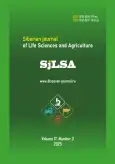Using Hydrus-1D software to predict cumulative infiltration values for different soil textures
- 作者: Al-Wazzan F.A.1
-
隶属关系:
- Department of Soil Science and Water Resources, College of Agriculture and Forestry, University of Mosul
- 期: 卷 17, 编号 3 (2025)
- 页面: 283-299
- 栏目: Agrochemistry and Agricultural Soil Science
- ##submission.datePublished##: 31.08.2025
- URL: https://journal-vniispk.ru/2658-6649/article/view/316257
- DOI: https://doi.org/10.12731/2658-6649-2025-17-3-1035
- EDN: https://elibrary.ru/KTSAMQ
- ID: 316257
如何引用文章
全文:
详细
Four soil samples with varying textures (clay loam, clay, sandy clay loam, and silty loam) were collected from different locations in Nineveh Governorate, northern Iraq. Four different models were used to calculate air-entry values, including Lenhard (Ψe), Cornelis (Ψe1), Van Genuchten (Ψe2), and a modified model proposed in this study (Ψe.m) and a modified model proposed in this study (α). These values, which represent the inverse of the air-entry value (α), serve as inputs for the Hydrus-1D program. It is a difficult standard to measure and requires time and work to estimate. These models were used in the Brooks and Corey model (1964) to predict accumulated infiltration. It is expressed in the following formulas (IΨe, IΨe1, IΨe2, IΨem). As a new method in predicting accumulated infiltration values by using the Hydrus-1D program and comparing it with infiltration values measured in the laboratory and field. This a novel scientific enhances the program's functionality and updates input data to minimize errors.
The results demonstrated that cumulative infiltration predicted by Hydrus-1D using hydraulic functions (,,) and the two constants in V.G model (α, n,) gave close values to the measured values. A high level of agreement was also observed between the predicted accumulated infiltration values (IΨe, IΨe1, IΨe2, IΨem) and the measured values when the same program was used, relying on the air-entry values of (Ψe, Ψe1, Ψe2, Ψe.m) as an alternative to the (α) value. The modified value in this study (Ψe.m) gave the best results to predict accumulated infiltration values when used in the Hydrus-1D program. We recommend adopting this modified value (Ψe.m) in Hydrus-1D to predict soil hydraulic properties.
作者简介
Faris Al-Wazzan
Department of Soil Science and Water Resources,College of Agriculture and Forestry, University of Mosul
编辑信件的主要联系方式.
Email: Dr.farisakram@uomosul.edu.iq
伊拉克, Mosul, Iraq
参考
- Simunek, J., Neumann, L.E., & Cook, F.J. (2011). Implementation of quadratic upstream interpolation schemes for solute transport into HYDRUS-1D. Environmental Modeling and Software, 26(11), 1298-1308. https://doi.org/10.1016/j.envsoft.2011.05.010
- Rezaei, M., Seuntjens, P., Shahidi, R., Joris, I., Boenne, W., Al-Barri, B., & Cornelis, W.M. (2016). The relevance of in situ and laboratory characterization of sandy soil hydraulic properties for soil water simulations. Journal of Hydrology, 534, 251-265. https://doi.org/10.1016/j.jhydrol.2015.12.062
- Kasel, D., Bradford, S.A., Simunek, J., Heggen, M., Vereecken, H., & Klumpp, E. (2013). Transport and retention of multi-walled carbon nanotubes in saturated porous media: Effects of input concentration and grain size. Water Research, 47(2), 933-944. https://doi.org/10.1016/j.watres.2012.11.019
- Dabach, S., Lazarovitch, N., Simunek, J., & Shani, U. (2013). Numerical investigation of irrigation scheduling based on soil water status. Irrigation Science, 31(1), 27-36. https://link.springer.com/article/10.1007/s00271-011-0289-x EDN: https://elibrary.ru/qgiygv
- Esam, M., AL-Qassab, S.A., & AL-Wazzan, F.A. (2022). Using inverse modeling by HYDRUS-1D to predict some soil hydraulic parameters from soil water evaporation. Colombia Forestal, 25, 21-35. https://doi.org/10.14483/2256201X.18157
- Mustafa, B.M., & Al-Wazzan, F.A. (2022). The variation of some soil physical properties by using water with different salinities. Int. J. Agricult. Stat. Sci., 18(1), 2099-2110. https://connectjournals.com/pages/articledetails/toc036676
- Al-Wazzan, F.A., & Sarbast, A.M. (2022). Effects of conservation and conventional tillage on some soil hydraulic properties. IOP Conf. Series: Earth and Environmental Science, 1060, 012002. https://doi.org/10.1088/1755-1315/1060/1/012002 EDN: https://elibrary.ru/yyyyzs
- Philip, J.R. (1957a). The theory of infiltration. 1: The infiltration equation and its solution. Soil Sci., 83, 345-357. https://journals.lww.com/soilsci/Citation/1957/05000/THE_THEORY_OF_INFILTRATION_1_THE_INFILTRATION.2.aspx
- Klute, A. (1986). Methods of soil analysis part 1: Physical and mineralogical methods (2nd ed.). Agronomy Monograph No.9. Madison, WI: ASA-SSSA. https://doi.org/10.2136/sssabookser5.1.2ed
- Parr, J.F., & Bertrand, A.R. (1960). Water infiltration into soils. Adv. In Agron, 12, 311-363. https://doi.org/10.1016/S0065-2113(08)60086-3
- Lenhard, R., Parker, J.C., & Mishra, S. (1989). On the correspondence between Brooks-Corey and van Genuchten model. J. Irrig. Drain. E., 115, 744-751. https://doi.org/10.1061/(ASCE)0733-9437(1989)115:4(744)
- Cornelis, V.M., Khlosi, M., Hartmann, R., van Meirvenne, M., & Devos, B. (2005). Comparison on unimodal analytical expression for soil water retention curve. Soil Sci. Soc. Am. J., 69, 1902-1911. https://journals.lww.com/soilsci/abstract/2012/06000/entropy_characterization_of_soil_pore_systems.1.aspx
- van Genuchten, M.Th. (1980). A closed-form equation for predicting the hydraulic conductivity of unsaturated soil. Soil Sci. Soc. Am. J., 44, 892-898. https://doi.org/10.2136/sssaj1980.036159950
- Philip, J.R. (1957b). The theory of infiltration. 2: The profile of infinity. Soil Sci., 83, 345-448. https://journals.lww.com/soilsci/Citation/1957/06000/The_Theory_of_Infiltration__2__the_Profile_of.3.aspx
- Hillel, D. (1980). Applications of soil physics. Academic press, New York.
- Ritter, A., Hupet, F., Munoz-Carpena, R., Lambot, S., & Vanclooster, M. (2003). Using inverse method for estimating soil hydraulic properties from field data as an alternative to direct methods. Agricultural Water Management, 59, 77-96. https://doi.org/10.1016/S0378-3774(02)00160-9 EDN: https://elibrary.ru/bfwujr
- Hachimi, M., Maslouhi, A., Tamoh, K., & Qanza, H. (2019). Estimation of soil hydraulic properties of basin Loukkos (Morocco) by inverse modeling. KSCE Journal of Civil Engineering, 23(3), 1407-1419. https://doi.org/10.1007/s12205-019-0628-7
- Dexter, A.R., & Richard, G.R. (2009). Tillage of soil in relation to their bimodal pore size distributions. Soil Tillage Res., 103, 113-118. https://doi.org/10.1016/j.still.2008.10.001
- Schaap, M.G., Leij, F.J., & van Genuchten, M.Th. (2001). Rosetta: a computer program for estimating soil hydraulic parameters with hierarch pedotransfer functions. Journal of Hydrology, 251(3-4), 163-176. https://doi.org/10.1016/S0022-1694(01)00466-8 EDN: https://elibrary.ru/arbjnj
- Simunek, J., Angulo-Jaramillo, R., Schaap, M.G., Martinus, J.V., & Van Genuchten, Th. (1998). Using an inverse method to estimate the hydraulic properties of crusted soil from tension-disc infiltrometer data. Geoderma, 86, 61-81. https://doi.org/10.1016/S0016-7061(98)00035-4 EDN: https://elibrary.ru/absmkd
- Vogel, T., van Genuchten, M.Th., & Cislerova, M. (2001). Effect of the shape of the soil hydraulic functions near saturation on variably-saturated flow predictions. Advances in Water Resources, 24, 133-144. https://doi.org/10.1016/S0309-1708(00)00037-3
- Mualem, Y. (1976). A new model predicting the hydraulic of unsaturated porous media. Water Resour. Res., 12(3), 513-522. https://doi.org/10.1029/WR012i003p00513
- Brooks, R.H., & Corey, A.T. (1964). Hydraulic properties of porous media. Hydrology paper No.3. Civil Engineering Department, Colorado State University, Fort Collins. https://api.mountainscholar.org/server/api/core/bitstreams/f7532f39-5f13-4e4b-a3c0-dd9523ba5219/content
补充文件










